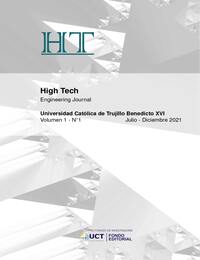Dinámica molecular 3D de la infección por SARSCoV2 fusión celular replicación viral y colapso homeostático
DOI:
https://doi.org/10.46363/high-tech.v5i1.06Palabras clave:
SARS-COV-2, replicación viral, homeostasisResumen
Este estudio presenta un modelo de simulación tridimensional basado en dinámica molecular para representar el proceso de infección del SARS-CoV-2 en células humanas, incorporando propiedades biofísicas esenciales como la carga eléctrica, polaridad e hidrofobicidad. Cada partícula del sistema representa componentes clave del virus (proteínas estructurales, espículas) y elementos de la célula huésped (membrana, receptores ACE2), modelando sus interacciones mediante fuerzas clásicas: de Van der Waals, electrostáticas y de confinamiento. La simulación, desarrollada en MATLAB, permite visualizar en tiempo real las tres fases principales del proceso infeccioso: entrada viral y fusión con la membrana celular, replicación viral cíclica con crecimiento exponencial del número de partículas y colapso progresivo de la homeostasis celular debido a la sobrecarga viral. Además, se incorporan parámetros biológicos como el ciclo de replicación y la respuesta estructural de la célula ante agentes externos, lo cual permite identificar el punto crítico de desestabilización del sistema. Este enfoque computacional permite comprender de forma visual y dinámica la complejidad de la interacción SARS-CoV-2–célula huésped, ofreciendo una herramienta educativa y de análisis preliminar para estudios virológicos y de biofísica celular.
Citas
Atkins, P., & de Paula, J. (2010). Physical Chemistry. Oxford University Press.
Einstein, A. (1905). Über die von der molekularkinetischen Theorie der Wärme geforderte Bewegung von in ruhenden Flüssigkeiten suspendierten Teilchen. Annalen der Physik, 322(8), 549-560.
Smoluchowski, M. (1906). Zur kinetischen Theorie der Brownschen Molekularbewegung und der Suspensionen. Annalen der Physik, 326(14), 756-780.
Bourouiba, L. (2020). Turbulent Gas Clouds and Respiratory Pathogen Emissions: Potential Implications for Reducing Transmission of COVID-19. JAMA, 323(18), 1837-1838.
Stadnytskyi, V., Bax, C. E., Bax, A., & Anfinrud, P. (2020). The airborne lifetime of small speech droplets and their potential importance in SARS-CoV-2 transmission. PNAS, 117(22), 11875-11877.
Bourouiba, L. (2020). Turbulent Gas Clouds and Respiratory Pathogen Emissions: Potential Implications for Reducing Transmission of COVID-19. JAMA, 323(18), 1837-1838. https://doi.org/10.1001/jama.2020.4756
Stadnytskyi, V., Bax, C. E., Bax, A., & Anfinrud, P. (2020). The airborne lifetime of small speech droplets and their potential importance in SARS-CoV-2 transmission. PNAS, 117(22), 11875-11877. https://doi.org/10.1073/pnas.2006874117
Morawska, L., & Cao, J. (2020). Airborne transmission of SARS-CoV-2: The world should face the reality. Environment International, 139, 105730. https://doi.org/10.1016/j.envint.2020.105730
Tellier, R., Li, Y., Cowling, B. J., & Tang, J. W. (2019). Recognition of aerosol transmission of infectious agents: a commentary. BMC Infectious Diseases, 19(1), 101. https://doi.org/10.1186/s12879-019-3707-y
Xie, X., Li, Y., Chwang, A. T., Ho, P. L., & Seto, W. H. (2007). How far droplets can move in indoor environments – revisiting the Wells evaporation–falling curve. Indoor Air, 17(3), 211-225. https://doi.org/10.1111/j.1600-0668.2007.00469.x
Einstein, A. (1905). On the movement of small particles suspended in stationary liquids required by the molecular-kinetic theory of heat. Annalen der Physik, 322(8), 549-560. https://doi.org/10.1002/andp.19053220806
Smoluchowski, M. (1906). Zur kinetischen Theorie der Brownschen Molekularbewegung und der Suspensionen. Annalen der Physik, 326(14), 756-780. https://doi.org/10.1002/andp.19063261405
Atkins, P., & de Paula, J. (2010). Physical Chemistry (9th ed.). Oxford University Press.
Vuorinen, V., Aarnio, M., Alava, M., Alopaeus, V., et al. (2020). Modelling aerosol transport and virus exposure with numerical simulations in relation to SARS-CoV-2 transmission by inhalation indoors. Safety Science, 130, 104866. https://doi.org/10.1016/j.ssci.2020.104866
Bazant, M. Z., & Bush, J. W. M. (2021). A guideline to limit indoor airborne transmission of COVID-Proceedings of the National Academy of Sciences, 118(17), e2018995118. https://doi.org/10.1073/pnas.2018995118.
Allen, M. P., & Tildesley, D. J. (2017). Computer simulation of liquids (2nd ed.). Oxford University Press.
Frenkel, D., & Smit, B. (2002). Understanding molecular simulation: From algorithms to applications (2nd ed.). Academic Press.
Zhu, J., & Huo, X. (2021). Molecular dynamics simulation of SARS-CoV-2: A review on structure and interactions. Frontiers in Molecular Biosciences, 8, 652573.
MacKerell, A. D., Jr., et al. (1998). All-atom empirical potential for molecular modeling and dynamics studies of proteins. Journal of Physical Chemistry B, 102(18), 3586-3616.
Baker, N. A., et al. (2001). Electrostatics of nanosystems: Application to microtubules and the ribosome. Proceedings of the National Academy of Sciences, 98(18), 10037-10041.
Descargas
Publicado
Número
Sección
Licencia
Derechos de autor 2025 Universidad Católica de Trujillo

Esta obra está bajo una licencia internacional Creative Commons Atribución 4.0.



